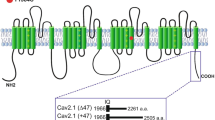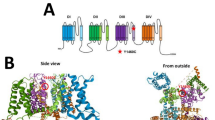Abstract
Background
Recessive mutations in the SLC4A4 gene cause a syndrome characterised by proximal renal tubular acidosis (pRTA), mental retardation, dental and ocular abnormalities, and hemiplegic migraine. Rare cases involving the development of epilepsy or its severe complication—status epilepticus—have been described.
Methods
The clinical and genetic status of four affected members in a Spanish family was studied. The SLC4A4 gene mutation was detected with a next-generation sequencing (NGS) panel in the proband, and Sanger confirmed the putative mutations in affected relatives. In silico analysis was performed to elucidate the putative effect of mutation on the splicing process.
Results
A novel mutation, c.2562+2T>G, was identified in the homozygous state in all diseased members of the family. This mutation affected a canonical splice site and is predicted to abolish the wild-type donor site, which predicts a premature truncated NBCe1 protein with cotransport activity. The resulting protein lacks the 190 amino acids of the carboxyl-terminus, and the effect is likely to be a loss of function. All patients suffered from severe pRTA and ocular abnormalities, and the adults also suffered from neurological complications, such as hemiplegic migraine and/or epilepsy. Two developed life-threatening status epilepticus, although they fully recovered and remained free of seizures with valproate.
Conclusion
These results expand the clinical and mutational spectra of SLC4A4-related disease and have implications for understanding the potential role of NBCe1 in the pathophysiologic processes of hemiplegic migraine and epilepsy/status epilepticus associated with the mutation.




Similar content being viewed by others
Data availability
The data that support the findings of this study are available from the corresponding author upon reasonable request. We confirm that we have read the journal’s position on issues involved in ethical publication and affirm that this report is consistent with those guidelines.
References
Igarashi T, Inatomi J, Sekine T, Cha SH, Kanai Y, Kunimi M, Tsukamoto K, Satoh H, Shimadzu M, Tozawa F, Mori T, Shiobara M, Seki G, Endou H (1999) Mutations in SLC4A4 cause permanent isolated proximal renal tubular acidosis with ocular abnormalities. Nat Genet 23(3):264–266
Lo Y-F, Yang S-S, Seki G, Yamada H, Horita S, Yamazaki O, Fujita T, Usui T, Tsai JD, Yu IS, Lin SW, Lin SH (2011) Severe metabolic acidosis causes early lethality in NBC1 W516X knock-in mice as a model of human isolated proximal renal tubular acidosis. Kidney Int 79(7):730–741
Suzuki M, Van Paesschen W, Stalmans I et al (2010) Defective membrane expression of the Na(+)-HCO(3)(−) cotransporter NBCe1 is associated with familial migraine. Proc Natl Acad Sci U S A 107(36):15963–15968
Dinour D, Chang M-H, Satoh J-I, Smith BL, Angle N, Knecht A, Serban I, Holtzman EJ, Romero MF (2004) A novel missense mutation in the sodium bicarbonate cotransporter (NBCe1/SLC4A4) causes proximal tubular acidosis and glaucoma through ion transport defects. J Biol Chem 279(50):52238–52246
Shiohara M, Igarashi T, Mori T, Komiyama A (2000) Genetic and long-term data on a patient with permanent isolated proximal renal tubular acidosis. Eur J Pediatr 159(12):892–894
Demirci FYK, Chang M-H, Mah TS, Romero MF, Gorin MB (2006) Proximal renal tubular acidosis and ocular pathology: a novel missense mutation in the gene (SLC4A4) for sodium bicarbonate cotransporter protein (NBCe1). Mol Vis 12:324–330
Suzuki M, Vaisbich MH, Yamada H, Horita S, Li Y, Sekine T, Moriyama N, Igarashi T, Endo Y, Cardoso TP, de Sá LCF, Koch VH, Seki G, Fujita T (2008) Functional analysis of a novel missense NBC1 mutation and of other mutations causing proximal renal tubular acidosis. Pflugers Arch 455(4):583–593
Horita S, Yamada H, Inatomi J, Moriyama N, Sekine T, Igarashi T, Endo Y, Dasouki M, Ekim M, al-Gazali L, Shimadzu M, Seki G, Fujita T (2005) Functional analysis of NBC1 mutants associated with proximal renal tubular acidosis and ocular abnormalities. J Am Soc Nephrol 16(8):2270–2278
Igarashi T, Sekine T, Inatomi J, Seki G (2002) Unraveling the molecular pathogenesis of isolated proximal renal tubular acidosis. J Am Soc Nephrol 13(8):2171–2177
Inatomi J, Horita S, Braverman N, Sekine T, Yamada H, Suzuki Y, Kawahara K, Moriyama N, Kudo A, Kawakami H, Shimadzu M, Endou H, Fujita T, Seki G, Igarashi T (2004) Mutational and functional analysis of SLC4A4 in a patient with proximal renal tubular acidosis. Pflugers Arch 448(4):438–444
Kari JA, El Desoky SM, Singh AK, Gari MA, Kleta R, Bockenhauer D (2014) The case | renal tubular acidosis and eye findings. Kidney Int 86(1):217–218
Patel N, Khan AO, Al-Saif M et al (2017) A novel mechanism for variable phenotypic expressivity in Mendelian diseases uncovered by an AU-rich element (ARE)-creating mutation. Genome Biol 18(1):144
Myers EJ, Yuan L, Felmlee MA, Lin YY, Jiang Y, Pei Y, Wang O, Li M, Xing XP, Marshall A, Xia WB, Parker MD (2016) A novel mutant Na+/HCO3-cotransporter NBCe1 in a case of compound-heterozygous inheritance of proximal renal tubular acidosis. J Physiol Lond 594(21):6267–6286
Horita S, Simsek E, Simsek T, Yildirim N, Ishiura H, Nakamura M, Satoh N, Suzuki A, Tsukada H, Mizuno T, Seki G, Tsuji S, Nangaku M (2018) SLC4A4 compound heterozygous mutations in exon-intron boundary regions presenting with severe proximal renal tubular acidosis and extrarenal symptoms coexisting with Turner’s syndrome: a case report. BMC Med Genet 19(1):103–109
Beniczky S, Hirsch LJ, Kaplan PW, Pressler R, Bauer G, Aurlien H, Brøgger JC, Trinka E (2013) Unified EEG terminology and criteria for nonconvulsive status epilepticus. Epilepsia 54(Suppl. 6):28–29
Richards S, Aziz N, Bale S et al (2015) Standards and guidelines for the interpretation of sequence variants: a joint consensus recommendation of the American College of Medical Genetics and Genomics and the Association for Molecular Pathology. Genet Med 17(5):405–424
Gurnett CA, Veile R, Zempel J, Blackburn L, Lovett M, Bowcock A (2008) Disruption of sodium bicarbonate transporter SLC4A10 in a patient with complex partial epilepsy and mental retardation. Arch Neurol 65(4):550–553
Striano P (2015) Epilepsy towards the next decade: new trends and hopes in epileptology. Springer International Publishing, Basel
Claramunt R, Sevilla T, Lupo V, Cuesta A, Millán JM, Vílchez JJ, Palau F, Espinós C (2007) The p.R1109X mutation in SH3TC2 gene is predominant in Spanish gypsies with Charcot-Marie-tooth disease type 4. Clin Genet 71(4):343–349
Cabrera-Serrano M, Mavillard F, Biancalana V, Rivas E, Morar B, Hernández-Laín A, Olive M, Muelas N, Khan E, Carvajal A, Quiroga P, Diaz-Manera J, Davis M, Ávila R, Domínguez C, Romero NB, Vílchez JJ, Comas D, Laing NG, Laporte J, Kalaydjieva L, Paradas C (2018) A Roma founder BIN1 mutation causes a novel phenotype of centronuclear myopathy with rigid spine. Neurology 91(4):e339–e348
Natera-de Benito D, Domínguez-Carral J, Muelas N, Nascimento A, Ortez C, Jaijo T, Arteaga R, Colomer J, Vilchez JJ (2016) Phenotypic heterogeneity in two large Roma families with a congenital myasthenic syndrome due to CHRNE 1267delG mutation. A long-term follow-up. Neuromuscul Disord 26(11):789–795
Funding
This study was supported by the Health Institute Carlos III–Ministry of Health of Spain ISCIII (Rio Hortega Fellowship CM12/00014).
Author information
Authors and Affiliations
Contributions
SGP and TJ designed the study and wrote the manuscript. RGR helped collect data and design figures. MM was the neuroradiologist that analysed CT and MRI data. AGV and PR performed and interpreted EEG data. SGP and SD were the attending physicians of the proband during admittance and follow-up, and SD is the head of the Headache Unit and helped revise the final manuscript. All authors read and approved of the final manuscript.
Corresponding author
Ethics declarations
Conflict of interest
The authors have no conflicts of interest to disclose.
Ethical approval
The institutional review board at the Health Institute in Hospital La Fe approved this study.
Informed consent statement
All studies were undertaken with the understanding and written consent of all subjects or next-of-kin involved and conformed with the World Medical Association Declaration of Helsinki.
Additional information
Publisher’s note
Springer Nature remains neutral with regard to jurisdictional claims in published maps and institutional affiliations.
Supplementary information
Figure S1
EEG reference montage. (PNG 4948 kb).
Rights and permissions
About this article
Cite this article
Gil-Perotín, S., Jaijo, T., Verdú, A.G. et al. Epilepsy, status epilepticus, and hemiplegic migraine coexisting with a novel SLC4A4 mutation. Neurol Sci 42, 3647–3654 (2021). https://doi.org/10.1007/s10072-020-04961-x
Received:
Accepted:
Published:
Issue Date:
DOI: https://doi.org/10.1007/s10072-020-04961-x




